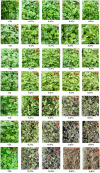Effects of alkaline salt stress on growth, physiological properties and medicinal components of clonal Glechoma longituba (Nakai) Kupr
- PMID: 39402458
- PMCID: PMC11475845
- DOI: 10.1186/s12870-024-05668-3
Effects of alkaline salt stress on growth, physiological properties and medicinal components of clonal Glechoma longituba (Nakai) Kupr
Abstract
Background: Glechoma longituba, recognized as a medicinal plant, provides valuable pharmaceutical raw materials for treating various diseases. Saline-alkali stress may effectively enhance the medicinal quality of G. longituba by promoting the synthesis of secondary metabolites. To investigate the changes in the primary medicinal components of G. longituba under saline-alkali stress and improve the quality of medicinal materials, Na2CO3 was applied to induce short-term stress under different conditions and the biomass, physiologically active substances and primary medicinal components of G. longituba were measured in this study.
Results: Under alkaline salt stress, the activities of catalase (CAT), superoxide dismutase (SOD), peroxidase (POD), and ascorbate peroxidase (APX) were elevated in G. longituba, accompanied by increased accumulation of proline (Pro) and malondialdehyde (MDA). Furthermore, analysis of the medicinal constituents revealed that G. longituba produced the highest levels of soluble sugars, flavonoids, ursolic acid, and oleanolic acid under 0.6% Na2CO3 stress for 48 h, 0.2% Na2CO3 stress for 72 h, 0.4% Na2CO3 stress for 12 h, and 0.4% Na2CO3 stress for 8 h, respectively.
Conclusions: Short-term Na2CO3 stress enhances the synthesis of medicinal components in G. longituba. By manipulating stress conditions, the production of various medicinal substances could be optimized. This approach may serve as a basis for the targeted cultivation of G. longituba, offering potential applications in the treatment of diverse diseases.
Keywords: Glechoma longituba; Active substance; Antioxidant; Medicinal constituents; Salt stress.
© 2024. The Author(s).
Conflict of interest statement
The authors declare no competing interests.
Figures








Similar articles
-
[Effects of soil bulk density on growth, physiology and quality of Glechoma longituba].Zhongguo Zhong Yao Za Zhi. 2018 Oct;43(19):3848-3854. doi: 10.19540/j.cnki.cjcmm.20180726.002. Zhongguo Zhong Yao Za Zhi. 2018. PMID: 30453708 Chinese.
-
Chemical constituents of Glechoma longituba.Yao Xue Xue Bao. 2006 May;41(5):431-4. Yao Xue Xue Bao. 2006. PMID: 16848319
-
[Circulated extraction of flavonoids from Glechoma longituba by ultrasonic wave].Zhongguo Zhong Yao Za Zhi. 2007 Mar;32(5):385-7. Zhongguo Zhong Yao Za Zhi. 2007. PMID: 17511139 Chinese.
-
Triticum aestivum: antioxidant gene profiling and morpho-physiological studies under salt stress.Mol Biol Rep. 2023 Mar;50(3):2569-2580. doi: 10.1007/s11033-022-07990-1. Epub 2023 Jan 10. Mol Biol Rep. 2023. PMID: 36626063
-
Balangu (Lallemantia sp.) growth and physiology under field drought conditions affecting plant medicinal content.Plant Physiol Biochem. 2018 Sep;130:641-646. doi: 10.1016/j.plaphy.2018.08.014. Epub 2018 Aug 9. Plant Physiol Biochem. 2018. PMID: 30138847
References
-
- Yuan Z-L, Chen X-B, Cai J, Huang L-Y, Guo S-H, Ouyang X-L. Polyphenols and Organic acids from Glechoma Longituba. Chem Nat Compd. 2023;59(3):562–4.
-
- Jin L, Liu L, Guo Q. Phosphorus and iron in soil play dominating roles in regulating bioactive compounds of Glechoma longituba (Nakai) Kupr. Sci Hort. 2019;256.
-
- Zhu Y-D, Zou J, Zhao W-M. Two new monoterpenoid glycosides from Glechoma Longituba. J Asian Nat Prod Res. 2008;10(2):199–204. - PubMed
-
- Ouyang XL, Qin F, Huang RZ, Liang D, Wang CG, Wang HS, et al. NF-kappaB inhibitory and cytotoxic activities of hexacyclic triterpene acid constituents from Glechoma Longituba. Phytomedicine. 2019;63:153037. - PubMed
MeSH terms
Substances
Grants and funding
LinkOut - more resources
Full Text Sources
Miscellaneous

